9 Books about the Life of the Buddha
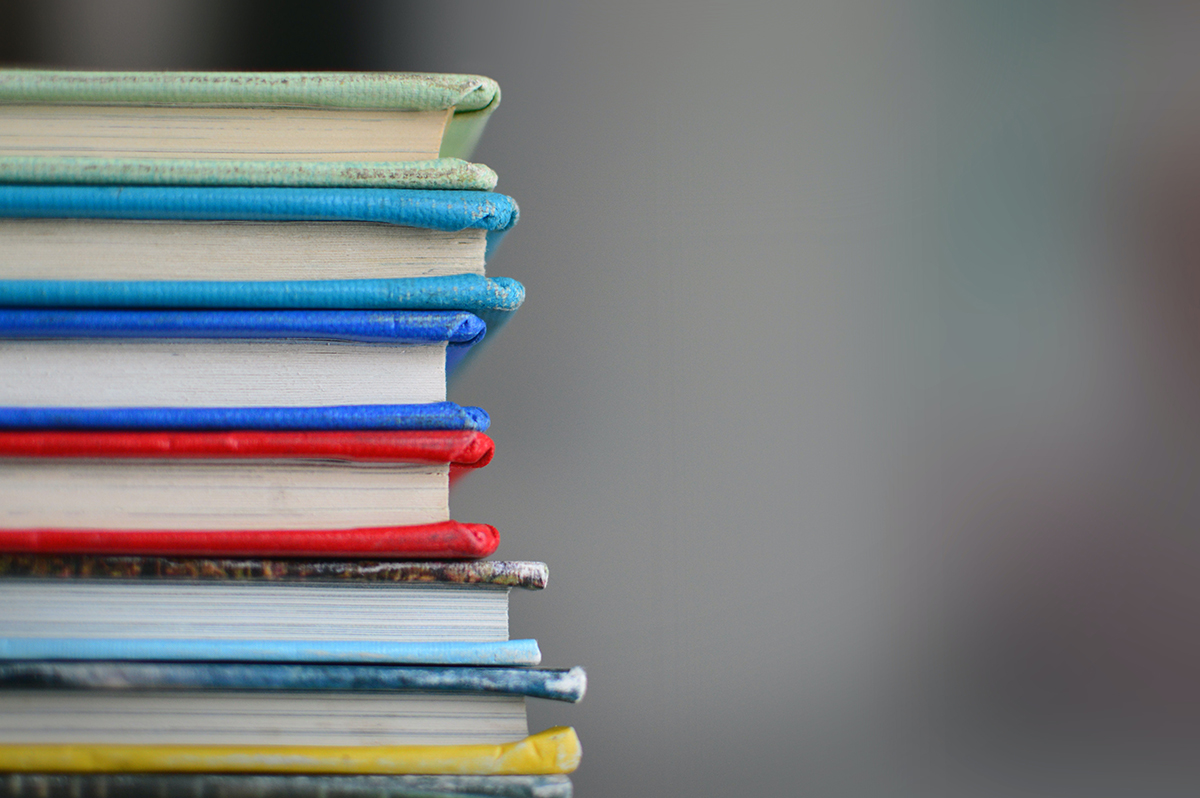
About This Resource
Details
Life of the Buddha Books
English Language
There are only a handful of books written in English about the life of the Buddha, Prince Siddhartha, Shakyamuni Buddha. There are likely more written in Asian languages. Here we are only looking at the English language offerings, focusing on a few criteria: illustration, story accuracy, handling of sensitive subjects, and age-appropriate literacy levels.
It’s important for parents to understand that Prince Siddhartha was an actual human being who lived, taught and died, some time during the 5th century BCE. It is not a fairy tale. The story is not drama filled and there are a few tricky parts (in some, not all renditions) that parents should be prepared to speak about—sickness and death, starvation, reincarnation. Some of these stories discuss good and evil spirits, invisible beings, heaven, demons, past lives, and then there is the fact that Buddha leaves his wife and child behind. We recommend pre-reading any book you intend to read to your child so that you can be prepared to “re-write” parts that they would either not understand or are not prepared to discuss.
We recommend pre-reading books so that you can be prepared to “re-write” parts that children would either not understand or are not prepared to discuss.
The story is about questioning the status quo, seeking truth, discovering the world for oneself, and ultimately relying on wisdom and kindness to benefit others. It’s also about accepting that there is suffering in the world and learning how to be okay with that. It’s about being humble and strong, selfless and dignified. It’s about not being swayed or caught in the net of external circumstances. But the fact is, there isn’t a lot of dramatic tension for authors to work with.
The crux of the story is of course that Buddha attained enlightenment. But what does that mean? The concept of enlightenment is not easy for adults to grasp, let alone children. Practitioners examine and reexamine the subject for the entire journey on the path. So we paid special attention to how Buddha’s enlightenment is described.
For non-Buddhists reading these stories, it’s good to know that the existence of the historical Buddha is not in conflict with other belief systems, except when reincarnation is made a focal point. Because many of the families at the school don’t identify as Buddhist, at the Middle Way School teachers generally stay away from reading the Jataka tales (more on that another time), which are the fanciful tales of the Buddha’s past lives.
There are ways to get around certain material you’re not ready to address. We sometimes alter stories slightly in the moment, when there is mention of a wise man, sometimes we say wise person or wise woman. And when all the delights in the palace are mentioned, we steer away from gender specific things like “pretty dancing girls and talented men.” It’s easy to swap out some of that language to present a more balanced view.
We have included all the books we felt were worth examining. There were a few others that had inaccurate information or heavy agendas that we left off the list.
Do you have another Buddhist children’s book to recommend? Please email your short review to [email protected] so we might consider adding it to our list. Thanks for reading!
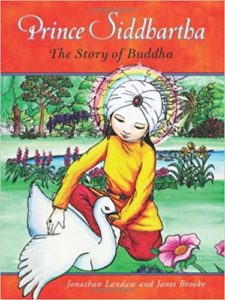
Prince Siddhartha: The Story Of Buddha
by Janet Brooke and Jonathan Landaw
Wisdom Publications, 2011 (144 pages)
HIGHLY RECOMMENDED
This is an illustrated long-format paperback chapter book of the journey of Prince Siddhartha and how he became the Tathagata, the Buddha, the Awakened One. The language is easily accessible and the book captured children’s imaginations during weekly storytime at Middle Way School. They liked it so much we read it again as soon as we had finished.
There are 30 chapters, which cover many of the important turning points in Buddha’s life. The authors did an excellent job selecting these points. Our students particularly liked the story of young Siddhartha and his cousin Devadatta arguing over the swan, which is featured on the front cover. They wove it into their school play.
The full-color illustrations, nearly one for every chapter, are elementary and sweet.
The messages of nonviolence, loving-kindness, and unselfishness come across in a non-dogmatic way and offer great jumping-off points for rich discussion.
Our only complaint about this book, and it’s a minor one, is that the printing quality is a bit thin. It’s fine but it would be nice to have a hardcover.
There is a companion coloring book of the illustrations that we photocopied so the children could color while listening. When they were finished coloring, we attached the sheets to a long ribbon and strung them across the room so we could reference the stories from time to time.
- BE AWARE: Mentions giving birth, death, pleasure palaces, good and evil spirits, invisible beings, heaven, demons, past lives, etc.
- ENLIGHTENMENT: Covered in two chapters starting on page 92, “The Great Battle” and “Awakened”: “When the last speck of darkness disappeared from his mind, he was filled with a radiant clear light. He was no longer an ordinary person. He had become fully enlightened to the truth. He was now a buddha, a fully awakened one. He had reached his goal!”
 The Life of the Buddha
The Life of the Buddha
Written by Heather Sanche
Illustrations by Tara di Gesu
Bala Kids, 2020 (44 pages)
HIGHLY RECOMMENDED
Among all the books we read, Tara di Gesu’s magical illustrations are unparalleled. Children and adults can look again and again at each image and keep finding fascinating details. Heather Sanche’s storytelling is poetic, clear, and concise. It’s the classic tale following Prince Siddhartha’s journey of truth-seeking and discovery, including his life-altering encounters with human suffering and his realization of the Four Noble Truths.
Most of this book focuses on his path to enlightenment, not what happened afterwards. Each of the four journeys out of the palace are given a two-page spread. He goes on to explore the Noble Truths. His teaching and death take up just a few pages at the end. We get some nice resolution of Prajapati (Buddha’s aunt and guardian after his mother’s death), and Buddha’s wife and son (Yashodara and Rahul remain nameless) join the sangha. The ending has a lovely look forward to the present day and how we have benefitted from Buddha’s teachings.
Di Gesu and Sanche, as well as Carolyn Kanjuro, who helped edit the book, are well attuned to the child reader. While all three are students of Tibetan Buddhism, they show no bias or agenda and the book stays true to the origin story that all traditions agree on. There’s a nice historical note at the end, which our children also enjoyed hearing.
- BE AWARE: Mentions death and shows the dying Buddha, lovely ladies and strong men, thoughts and feelings looming “like demons in the sky”
- ENLIGHTENMENT: “He was not pulled by pleasant thoughts nor harmed by frightening ones. And he discovered the noble truth that the cause of suffering is being attached to feelings and experiences that come and go.” (page 34) “As the morning star rose in the eastern sky, yet another noble truth dawned in his heart. ‘There is an end to suffering,’ he realized. For he himself had gone beyond all suffering. He had become the Buddha, the Awakened One. He knew this, beyond any doubt, and did not need anyone else to tell him it was so.” (page 36)
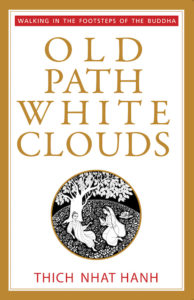 Old Path White Clouds: Walking in the Footsteps of the Buddha
Old Path White Clouds: Walking in the Footsteps of the Buddha
By Thich Nhat Hanh
Illustrations by Nyugen Thi Hop
Parallax Press (598 pages)
HIGHLY RECOMMENDED
This seminal text by Vietnamese monk, poet, and peace activist, revered around the world for his teachings on mindfulness, ethics, and peace, is recommended by many lamas, teachers, and students and is appropriate for adults and children alike. It’s long, but broken up into 2 books with a total of 81 chapters. There are summaries of each chapter in the appendix at the end as well as a map of the area where Buddha roamed, and an excellent appendix of Pali and Sanskrit terms.
An interesting aspect of this book is that the chapters are not in sequential order of the story of the Buddha’s life and there is no description of his enlightenment. He’s teaching sutras in chapter 2 and is born in chapter 6. Chapter 30 presents the Five Precepts. In this way the story flows more from the teachings and it can be read out of order.
One Buddhist mom said she read Old Path, White Clouds cover to cover as a bedtime story to her young daughter. “It was this special place that she and I went to every night. It wasn’t action-packed but it had so much atmosphere, at least for us. It was like we went on a journey every night. It was so gentle. I remember reading every night for about half an hour.” The daughter, now all grown up, recalls this as a very special time. “Even if I don’t remember all the details from the stories, they left a lasting impression. It was the first time I was connected with the Buddha, and through the telling, I developed an affection for him as a main character. This later turned into something more. But at the time, that seed of just really liking this guy Siddhartha was important. The book became a bridge for my mom to share Buddhism with me, which I know she was happy about. That joy of reading something that was so dear to her made it stand out from other bedtime stories and I could feel that.”
The Amazon description of the book states: “Old Path White Clouds presents the life and teachings of Gautama Buddha. Drawn directly from 24 Pali, Sanskrit, and Chinese sources, and retold by Thich Nhat Hanh in his inimitable beautiful style, this book traces the Buddha’s life slowly and gently over the course of 80 years, partly through the eyes of Svasti, the buffalo boy, and partly through the eyes of the Buddha himself…”
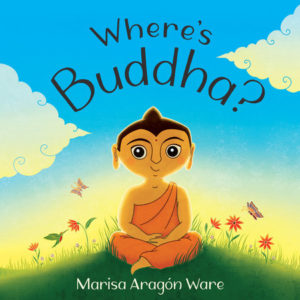 Where’s Buddha
Where’s Buddha
By Marisa Aragón Ware
Bala Kids, 2019 (20 pages)
HIGHLY RECOMMENDED
Where’s Buddha is a wonderfully illustrated picture book for younger children with rhyming text that is accessible and very age-appropriate. It doesn’t tell the historical story of the life of the Buddha, but we include it because in a way it tells the story of the Buddha of beginningless time, the Buddha that is everywhere and has always been, from deep in the ocean to beyond the moon. Our favorite spread is the one that says “Buddha is in the hearts of all.” We wish it had gone a step further to say we all are the Buddha!
There is nothing sensitive to be aware of and no mention of enlightenment.
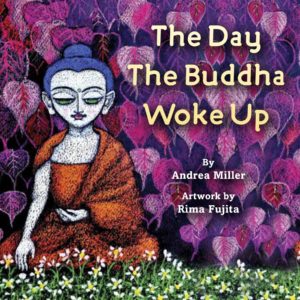 The Day the Buddha Woke Up
The Day the Buddha Woke Up
Written by Andrea Miller
Illustrations by Rima Fujita
Wisdom Publications, 2018 (18 pages)
HIGHLY RECOMMENDED
The Day the Buddha Woke Up was written with very young children in mind, and tells the story of the Buddha’s life and path from birth to enlightenment in clear, simple prose. A board book, its concise 18 pages are delightfully illustrated by internationally renowned artist Rima Fujita. Author Andrea Miller, the deputy editor of Lion’s Roar Magazine, has emphasized that the book is not just for Buddhist families, but rather can be a tool for non-Buddhists to learn about another religion, and it is in this spirit that she wrote this sweet introduction to the teachings of the Buddha.
There is nothing sensitive to be aware of and no mention of enlightenment.
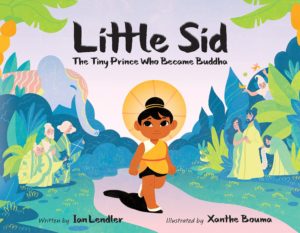 Little Sid: The Tiny Prince Who Became Buddha
Little Sid: The Tiny Prince Who Became Buddha
By Ian Lendler
Illustrations by Xanthe Bouma
First Second Books (30 pages)
The illustrations and fanciful use of text make this book a fun read for kids. It’s short and can be read in one sitting. Like the popular Mo Willems books, there are two sets of text on the pages, the narrative and then the inter-illustration conversations. Calling Siddhartha “Sid” makes him perhaps a little more relatable. It also gives the authors liberty to write a story that is not really about Gautama Buddha, though there are similarities. Sid is portrayed as a disgruntled young lord, tired of being spoiled. The book does a great job of showing how tiresome being spoiled can be and how exhausting it is to try to fill every moment with external satisfactions.
There is no mention of the four signs or the four sights (sickness, old age, death, asceticism), Sid goes straight out the door on his search for happiness. The turning point of the story has him running from a tiger and falling from a cliff. Dangling from a vine he notices a strawberry which he tastes and finds to be extra delicious, with the help of a mouse who is observing his predicament. This moment of being present seems to be a placeholder for his enlightenment, which is a little troubling. The external satisfaction of a strawberry while nearly dying seems to have made him a total renunciant. He’s learned to live in the moment. “Be Here Now,” are his final words.
Still, it’s a fun book with truly wonderful illustrations. There is nothing sensitive to be aware of and no mention of enlightenment.
Suggested activity: We asked our students what being spoiled means and to give examples and they had wonderful answers. They loved this question.
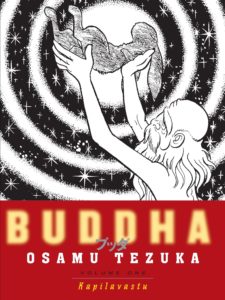 Buddha
Buddha
By Osamu Tezuka
HarperCollins (8 volume set)
This is an engrossing graphic novel series. However, there is nudity and violence in these books so we weren’t able to put them out for the kids. Perhaps for older teens.
It has been adapted into two animated feature films full of drama, which signals that some liberties were taken to make the story have more tension.
From Amazon
Osamu Tezuka’s vaunted storytelling genius, consummate skill at visual expression, and warm humanity blossom fully in his eight-volume epic of Siddhartha’s life and times. Tezuka evidences his profound grasp of the subject by contextualizing the Buddha’s ideas; the emphasis is on movement, action, emotion, and conflict as the prince Siddhartha runs away from home, travels across India, and questions Hindu practices such as ascetic self-mutilation and caste oppression. Rather than recommend resignation and impassivity, Tezuka’s Buddha predicates enlightenment upon recognizing the interconnectedness of life, having compassion for the suffering, and ordering one’s life sensibly. Philosophical segments are threaded into interpersonal situations with ground-breaking visual dynamism by an artist who makes sure never to lose his readers’ attention.
Tezuka himself was a humanist rather than a Buddhist, and his magnum opus is not an attempt at propaganda. Hermann Hesse’s novel or Bertolucci’s film is comparable in this regard; in fact, Tezuka’s approach is slightly irreverent in that it incorporates something that Western commentators often eschew, namely, humor.
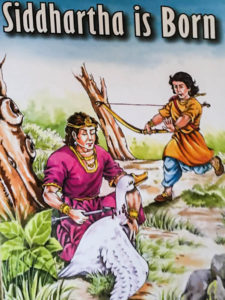 The Life of Buddha: Siddhartha is Born
The Life of Buddha: Siddhartha is Born
No author
Rohan Books, 2006 (20 pages)
This book seems to be one of a series. It only covers the prophecy of Buddha’s birth, his birth Queen Mahamaya’s death, several pages devoted to the swan story, his courtship of Yashodara. This is the only book in which Prajapati Gotami is introduced, Siddhartha’s auntie who took care of him after Maya died. There are some classist ideas in the book, and women in the story are all wives or caretakers. The illustrations similarly depict men’s and women in a cartoonish, unrealistic manner, and in a style that hearkens back to old-fashioned Disney movies.
 Buddha Stories
Buddha Stories
By Demi
Henry Holt, 1997 (28 pages)
Jataka Tales
At Middle Way we choose not to retell the Jataka Tales, which are a collection of stories originally written in Ceylon in Singhalese then translated into Pali around 430 a.d. They are meant to be the Buddha’s own tales of his past lives as various animals. The stories are from a different time, very moralistic, often violent. Reincarnation is a complicated thing to explain to children. Nonetheless, this book is extraordinary to look at, with twelve stories and twelve illustrations. Each story is just one page long with a moral at the end. The morals are cryptic or heavy: “Heaven is for those whose hearts are true” and “Don’t be deceived by a donkey in a lion’s skin.” It would take quite a lot of work to make this book relatable to children. The unusual gold print on black paper is striking. The illustrations are made with very fine lines using pen and ink “sometimes a single mouse whisker.”
